Road Tunnels Operation: Effectiveness of Emergency Teams as a Risk Mitigation Measure
Abstract
:1. Introduction
- What could happen inside the tunnel system?
- What is the probability of occurrence of the event?
- Having established that the event occurs, what are its possible consequences?
2. Background
- Category 1: even without external intervention, the power of these fires is unlikely to cause injury to tunnel users;
- Category 2: these fires are likely to cause casualties among tunnel users. Although they present considerable difficulties, the fire and rescue services are still able to intervene;
- Category 3: the power of these fires is so high that even well-equipped firefighters cannot risk an approach.
3. Analysis of the Interventions Carried out by the Emergency Teams of Strada dei Parchi S.p.A.
4. Emergency Teams’ Effectiveness Evaluation
- Slower-developing fires, characterized by a probability of occurrence of about 70% (see Table 3), are always controlled/extinguished, as the time limit of 13 min is higher than the time limit adopted in the risk analysis (10 min);
- Fast-developing fires, which represent about 30%, are characterized by an intervention time limit of 8 min, lower than the time limit adopted in the risk analysis (10 min). It follows that about 80% of fast-developing fires can be controlled/extinguished.
- Class II is the percentage of tunnels in Class II;
- FF is the percentage of fast-developing fires;
- FFCE is the percentage of fast-developing fires controlled or extinguished;
- SF is the percentage of slow-developing fires;
- SFCE is the percentage of slow-developing fires controlled or extinguished.
- NCF is the percentage of noncontrollable fires;
- Class III is the percentage of tunnels in Class III (100% − Class II = 100% − 94% = 6%);
- FF is the percentage of fast-developing fires.
- CASE 1: 0.05 (5%) if the emergency team and water supply measures are present;
- CASE 2: 0.15 (15%) if the emergency team measure is not present, but the water supply measure is available;
- CASE 3: 0.10 (10%) if the emergency team measure is present, but the water supply measure is not available;
- CASE 4: 0.33 (33%) if both safety measures are not present.
- Guarantee intervention within 10 min;
- Have specific and proven training;
- Have suitable equipment and facilities;
- Possess a detailed knowledge regarding the tunnel system in which they operate;
- Are in constant communication with the control center, which provides information on the evolution of the accident scenario.
5. Conclusions and Possible Developments
Author Contributions
Funding
Institutional Review Board Statement
Informed Consent Statement
Data Availability Statement
Acknowledgments
Conflicts of Interest
References
- Król, A.; Król, M. Numerical investigation on fire accident and evacuation in a urban tunnel for different traffic conditions. Tunn. Undergr. Space Technol. 2021, 109, 103751. [Google Scholar] [CrossRef]
- European Union. Directive 2004/54/EC on Minimum Safety Requirements for Tunnels in the TRANS-European Road Network; European Union: Brussels, Belgium, 2004. [Google Scholar]
- Król, A.; Król, M. The factors determining the number of the endangered people in a case of fire in a road tunnel. Fire Saf. J. 2020, 111, 102942. [Google Scholar] [CrossRef]
- Bassan, S. Overview of traffic safety aspects and design in road tunnels. IATSS Res. 2016, 40, 35–46. [Google Scholar] [CrossRef] [Green Version]
- Ma, Z.; Shao, C.; Zhang, S. Characteristics of traffic accidents in Chinese freeway tunnels. Tunn. Undergr. Space Technol. 2009, 24, 350–355. [Google Scholar] [CrossRef]
- Lemke, K. Road safety in tunnels. Transp. Res. Rec. 2000, 1740, 170–174. [Google Scholar] [CrossRef]
- Mashimo, H. State of the road tunnel safety technology in Japan. Tunn. Undergr. Space Technol. 2002, 17, 145–152. [Google Scholar] [CrossRef]
- Amundsen, F.H.; Ranes, G. Studies on Traffic Accidents in Norwegian Road Tunnels II. An Analysis of Traffic Accidents on Road Tunnels 2001–2006; Road and Traffic Depatment Traffic Safety Section, Statens Vegvesen: Oslo, Norway, 2009. [Google Scholar]
- Nussbaumer, C. Austrian Road Safety Board Comparative Analysis of Safety in Tunnels. In Proceedings of the 3rd Young Researchers Seminar, Brno, Czech Republic, 27–30 May 2007; Available online: https://www.semanticscholar.org/paper/COMPARATIVE-ANALYSIS-OF-SAFETY-IN-TUNNELS-Cornelia-Board/07637e882f31873daad4e1dac92751581a18a00e (accessed on 11 November 2022).
- Caliendo, C.; De Guglielmo, M.L. Accident rates in road tunnels and social costs evaluation. SIIV—5 International Congress—Sustainability of Road Infrastructures. Procedia Soc. Behav. Sci. 2012, 53, 166–177. [Google Scholar] [CrossRef] [Green Version]
- Pervez, A.; Huang, H.; Han, C.; Wang, J.; Li, Y. Revisiting freeway single tunnel crash characteristics analysis: A six-zone analytic approach. Accid. Anal. Prev. 2020, 142, 105542. [Google Scholar] [CrossRef]
- Kaplan, S.; Garrick, B.J. On the quantitative definition of risk. Risk Anal. 1981, 1, 11–27. [Google Scholar] [CrossRef]
- Kaplan, S. The words of risk analysis. Risk Anal. 1997, 17, 407–417. [Google Scholar] [CrossRef]
- Senato della Repubblica Italiana. Relazione Concernente lo Stato di Attuazione Degli Interventi Relative All’adeguamento Delle Gallerie Stradali Della Rete Transeuropea; Ministero Delle Infrastrutture e dei Trasporti: Rome, Italy, 2013. (In Italian) [Google Scholar]
- Pastori, E.; Brambilla, M.; Apicella, D.; Jarvis, A. Study on the Implementation and Effects of Directive 2004/54/EC on Minimum Safety Requirements for Road Tunnels in the Trans-European Road Network. Final Report; European Commission Directorate General for Mobility and Transport: Brussels, Belgium, 2015. [Google Scholar]
- Abbasnejadfard, M.; Bastami, M.; Abbasnejadfard, M.; Borzoo, S. Novel deterministic and probabilistic resilience assessment measures for engineering and infrastructure systems based on the economic impacts. Int. J. Disaster Risk Reduct. 2022, 75, 102956. [Google Scholar] [CrossRef]
- Wei, D.; Rose, A.; Koc, E.; Chen, Z.; Soibelman, L. Socioeconomic impacts of resilience to seaport and highway transportation network disruption. Transp. Res. Part D Transp. Environ. 2022, 106, 103236. [Google Scholar] [CrossRef]
- Ansari Esfeh, M.; Kattan, L.; Lam, W.H.K.; Salari, M.; Ansari Esfe, R. Road network vulnerability analysis considering the probability and consequence of disruptive events: A spatiotemporal incident impact approach. Transp. Res. Part C Emerg. Technol. 2022, 136, 103549. [Google Scholar] [CrossRef]
- Mattsson, L.; Jenelius, E. Vulnerability and resilience of transport systems—A discussion of recent research. Transp. Res. Part A Policy Pract. 2015, 81, 16–34. [Google Scholar] [CrossRef]
- Reggiani, A. Network resilience for transport security: Some methodological considerations. Transp. Policy 2013, 28, 63–68. [Google Scholar] [CrossRef]
- Carlson, J.L.; Haffenden, R.A.; Bassett, G.W.; Buehring, W.A.; Collins, M.J.; Folga, S.M.; Petit, F.D.; Phillips, J.A.; Verner, D.R.; Whitfield, R.G. Resilience: Theory and Application; No. ANL/DIS-12-1; Argonne National Lab.: Argonne, IL, USA, 2012. [Google Scholar]
- Bjelland, H.; Njå, O.; Heskestad, A.W.; Braut, G.S. Emergency preparedness for tunnel fires—A systems-oriented approach. Saf. Sci. 2021, 143, 105408. [Google Scholar] [CrossRef]
- Alvear, D.; Abreu, O.; Cuesta, A.; Alonso, V. Decision support system for emergency management: Road tunnels. Tunn. Undergr. Space Technol. 2013, 34, 13–21. [Google Scholar] [CrossRef]
- Dubois, H.; Lamontagne, M. Engineering Analysis to Improve Safety of the Melocheville Tunnel as Recommended in the NFPA 50. In Proceedings of the Seventh International Symposium on Tunnel Safety and Security, ISTSS, Montréal, QC, Canada, 16–18 March 2016; pp. 229–238. [Google Scholar]
- Bosco, D.; Lovreglio, R.; Frassoldati, A.; Derudi, M.; Borghetti, F. Queue formation and evacuation modelling in road tunnels during fires. Chem. Eng. Trans. 2018, 67, 805–810. [Google Scholar] [CrossRef]
- Lovreglio, R.; Ronchi, E.; Nilsson, D. An Evacuation Decision Model based on perceived risk, social influence and behavioural uncertainty. Simul. Model. Pract. Theory 2016, 66, 226–242. [Google Scholar] [CrossRef]
- Lovreglio, R.; Fonzone, A.; dell’Olio, L.; Borri, D. A Study of Herding Behavior in Exit Choice during Emergencies based on Random Utility Theory. Saf. Sci. 2016, 82, 421–431. [Google Scholar] [CrossRef]
- Caliendo, C.; Genovese, G.; Russo, I. A numerical study for assessing the risk reduction using an emergency vehicle equipped with a micronized water system for contrasting the fire growth phase in road tunnels. Appl. Sci. 2021, 11, 5248. [Google Scholar] [CrossRef]
- Ayyub, B.M. Systems resilience for multihazard environments: Definition, metrics, and valuation for decision making. Risk Anal. 2013, 34, 340–355. [Google Scholar] [CrossRef] [PubMed]
- Borghetti, F.; Petrenj, B.; Trucco, P.; Calabrese, V.; Ponti, M.; Marchionni, G. Multi-level approach to assessing the resilience of road network infrastructure. Int. J. Crit. Infrastruct. 2021, 17, 97–132. [Google Scholar] [CrossRef]
- Caliendo, C.; Genovese, G.; Russo, I. A simultaneous analysis of the user safety and resilience of a twin-tube road tunnel. Appl. Sci. 2022, 12, 3357. [Google Scholar] [CrossRef]
- Borghetti, F.; Derudi, M.; Gandini, P.; Frassoldati, A.; Tavelli, S. Safety in Road Tunnels. In Tunnel Fire Testing and Modeling; Springer: Cham, Switzerland, 2017. [Google Scholar] [CrossRef]
- Derudi, M.; Borghetti, F.; Favrin, S.; Frassoldati, A. TRAM: A New Quantitative Methodology for Tunnel Risk Analysis. In Chemical Engineering Transactions; AIDIC: Milan, Italy, 2018; pp. 811–816. ISBN 978-88-95608-64-8. [Google Scholar] [CrossRef]
- Borghetti, F.; Cerean, P.; Derudi, M.; Frassoldati, A. Road Tunnels Risk Analysis. In Road Tunnels; Springer: Cham, Switzerland, 2019. [Google Scholar] [CrossRef]
- Borghetti, F.; Derudi, M.; Frassoldati, A.; Lai, I.; Trinchini, C. Tunnel risk analysis: A quantitative evaluation of the effectiveness of emergency teams inside the A24 and A25 motorway tunnels. Chem. Eng. Trans. 2020, 82, 277–282. [Google Scholar] [CrossRef]
- Gehandler, J. Evaluation of Road Tunnel Fire Safety and Risk. In Proceedings of the 7th International Symposium on Tunnel Safety and Security, ISTSS, Montréal, QC, Canada, 16–18 March 2016; pp. 217–228. [Google Scholar]
- FSV. Methodology of Tunnel Risk Analysis. Austrian Association for Research on Road, Rail and Transport. Guideline RVS 09.03.11. 2015. Available online: http://www.fsv.at/shop/produktdetail.aspx?IDProdukt=fabe3274-1ec7-4963-ac28-c3c5804c3126 (accessed on 11 November 2022).
- Technical Committee C 3.3 Road Tunnel Operations. Management of the Operator—Emergency Teams Interface in Road Tunnels; 2008R03; PIARC: La Défense, France, 2008. [Google Scholar]
- Kim, H.K.; Lönnermark, A.; Ingason, H. Effective Firefighting Operations in Road Tunnels; SP Technical Research Institute of Sweden: Borås, Sweden, 2010. [Google Scholar]
- Ingason, H.; Li, Y.Z.; Lönnermark, A. Tunnel Fire Dynamics; Springer: New York, NY, USA, 2015. [Google Scholar]
- Rattei, G.; Lentz, A.; Kohl, B. How Frequent are the Fire in Tunnels—Analysis from Austrian Tunnel Incident Statistics? In Proceedings of the Seventh International Conference on Tunnel Safety and Ventilation, Graz, Austria, 12–13 May 2014; pp. 5–11. [Google Scholar]
- Nævestad, T.; Meyer, S. A survey of vehicle fires in Norwegian road tunnels 2008–2011. Tunn. Undergr. Space Technol. 2014, 41, 104–112. [Google Scholar] [CrossRef] [Green Version]
- Technical Committee 3.3 Road Tunnel Operation. Experience with Significant Incidents in Road Tunnels; 2016R35EN; PIARC: La Défense, France, 2017; ISBN 978-2-84060-444-0. [Google Scholar]
- Ren, R.; Zhou, H.; Hu, Z.; He, S.; Wang, X. Statistical analysis of fire accidents in Chinese highway tunnels 2000–2016. Tunn. Undergr. Space Technol. 2019, 83, 452–460. [Google Scholar] [CrossRef]
- Casey, N. Fire incident data for australian road tunnels. Fire Saf. J. 2020, 111, 102909. [Google Scholar] [CrossRef]
- Rhodes, N.; MacDonald, M. European Thematic Network Fire in Tunnels; Fire Response Management (Technical Report Part 3); FIT: Brussels, Belgium, 2005. [Google Scholar]
- Beard, A.; Carvel, R. The Handbook of Tunnel Fire Safety; Thomas Telford Services Ltd.: London, UK, 2005. [Google Scholar]
- Chen, F.; Chien, S.; Lee, Y.; Lin, C.; Sie, H. The integrated strategies for fire safety of long road tunnels in Taiwan. Pap. Presented Procedia Eng. 2013, 62, 36–45. [Google Scholar] [CrossRef] [Green Version]
- Kirytopoulos, K.; Konstandinidou, M.; Nivolianitou, Z.; Kazaras, K. Embedding the human factor in road tunnel risk analysis. Process Saf. Environ. Prot. 2014, 92, 329–337. [Google Scholar] [CrossRef]
- Manca, D.; Brambilla, S. A methodology based on the analytic hierarchy process for the quantitative assessment of emergency preparedness and response in road tunnels. Transp. Policy 2011, 18, 657–664. [Google Scholar] [CrossRef]
- Holgersson, A.; Eklund, A.; Gyllencreutz, L.; Saveman, B.-I. Emergency medical response in mass casualty tunnel incidents-with emphasis on prehospital care. J. Hum. Secur. 2020, 16, 3–15. [Google Scholar] [CrossRef]
- Doohan, I.S.; Saveman, B.-I.; Gyllencreutz, L. Limited medical perspective at a strategic level in relation to mass casualty incidents in swedish tunnels. Int. J. Emerg. Manag. 2019, 15, 360–374. [Google Scholar] [CrossRef]
- Palm, A.; Kumm, M.; Ingason, H. Full scale firefighting tests in the Tistbrottet Mine. Fire Technol. 2016, 52, 1519–1537. [Google Scholar] [CrossRef]
- Borghetti, F.; Frassoldati, A.; Derudi, M.; Lai, I.; Trinchini, C. Resilience and Emergency Management of Road Tunnels: The Case Study of the San Rocco and Stonio Tunnels in Italy. WIT Trans. Built Environ. 2021, 206, 81–92. [Google Scholar] [CrossRef]
- Borghetti, F.; Cerean, P.; Derudi, M.; Frassoldati, A. Road Tunnels An Analytical Model for Risk Analysis; PoliMI Springer Briefs; Springer: Cham, Switzerland, 2019; ISBN 978-3-319-49516-3. ISSN 2282-2577. [Google Scholar] [CrossRef]
- Barabino, B.; Bonera, M.; Maternini, G.; Olivo, A.; Porcu, F. Bus crash risk evaluation: An adjusted framework and its application in a real network. Accid. Anal. Prev. 2021, 159, 106258. [Google Scholar] [CrossRef]



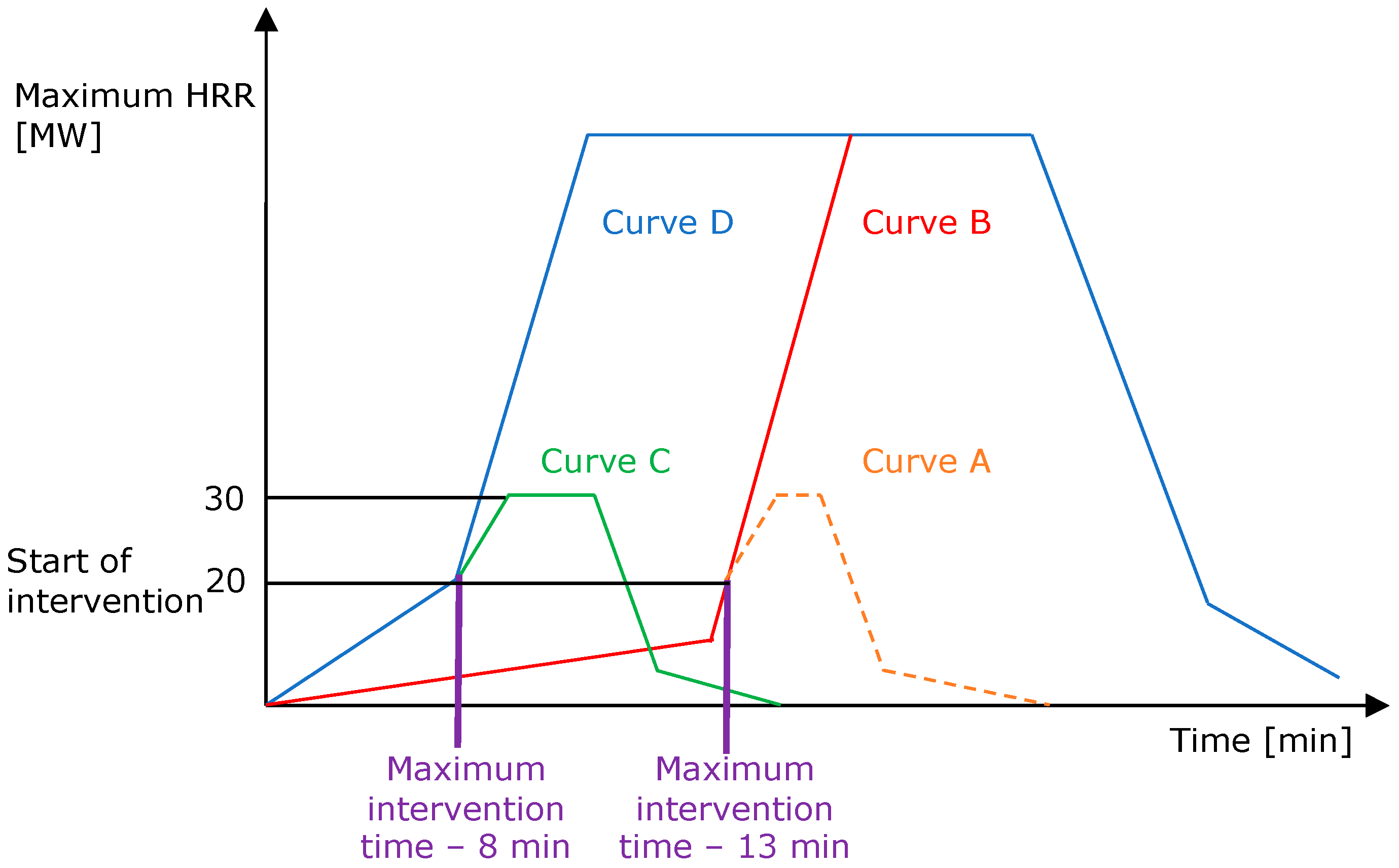




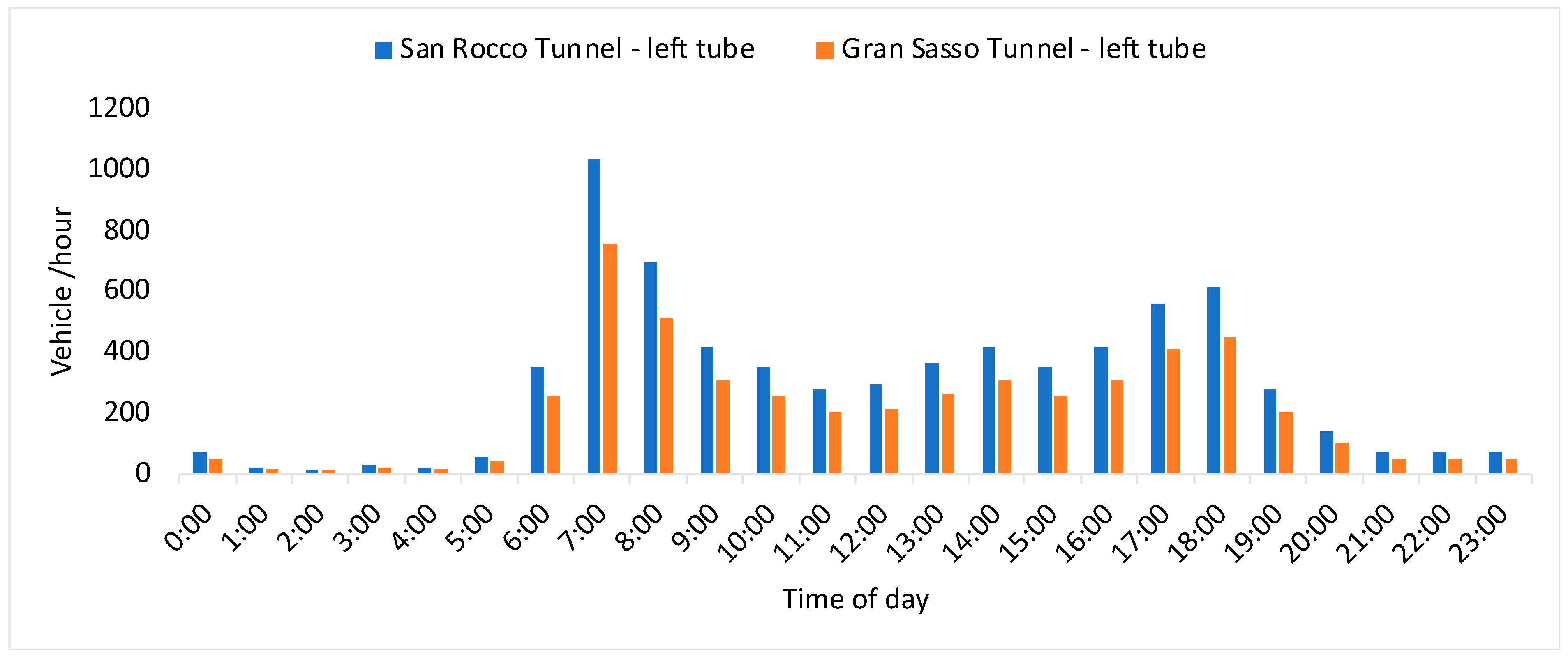


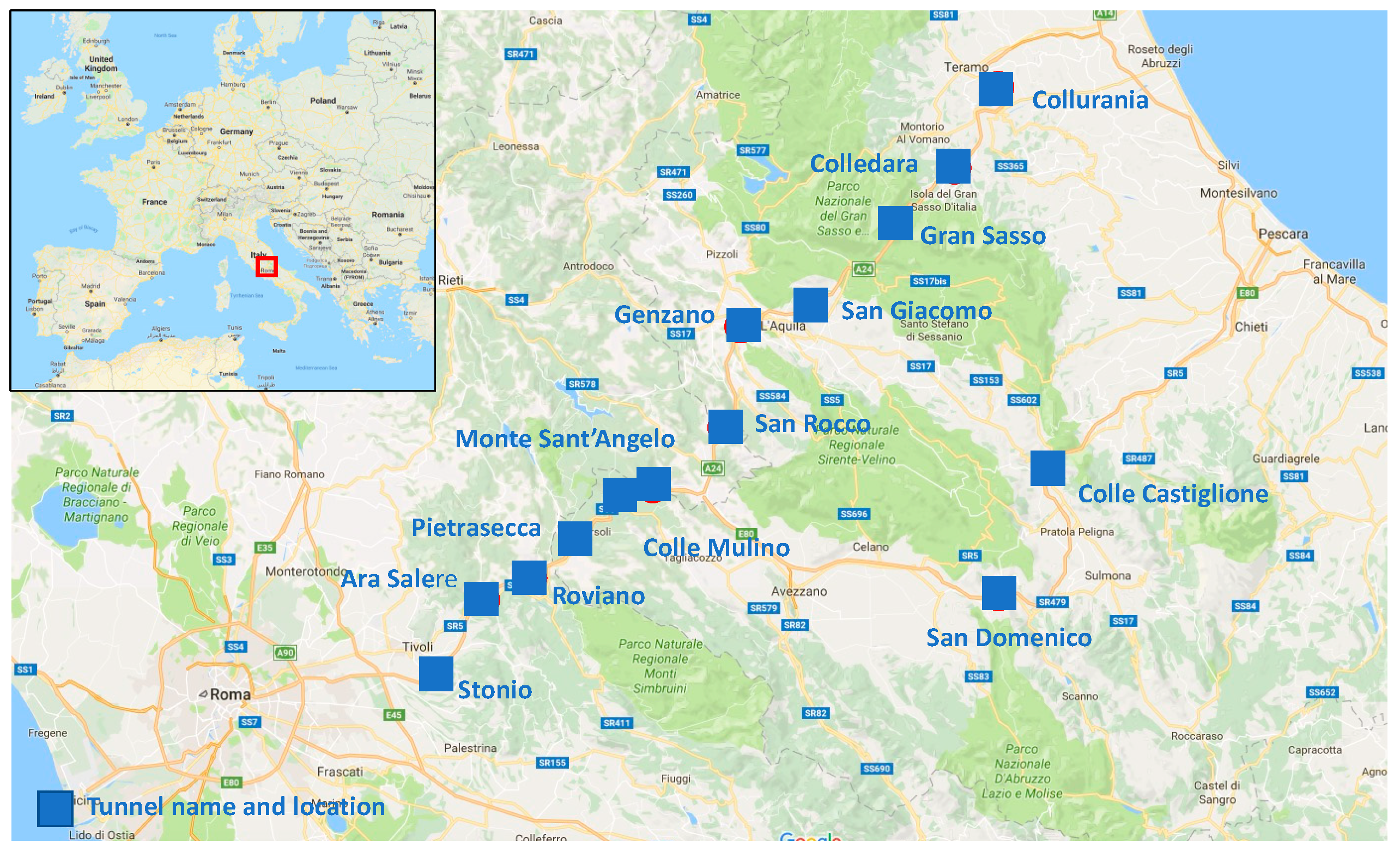


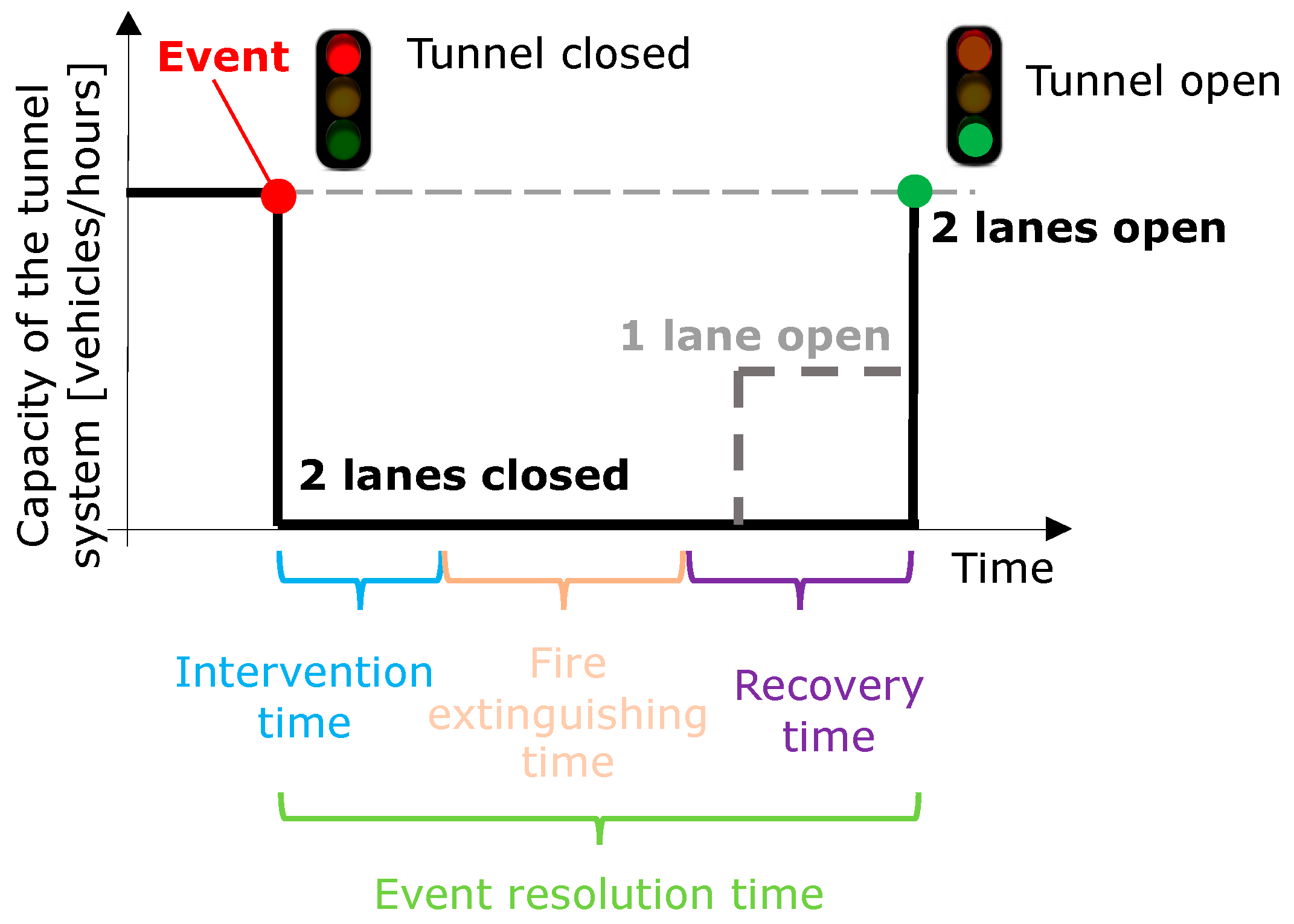


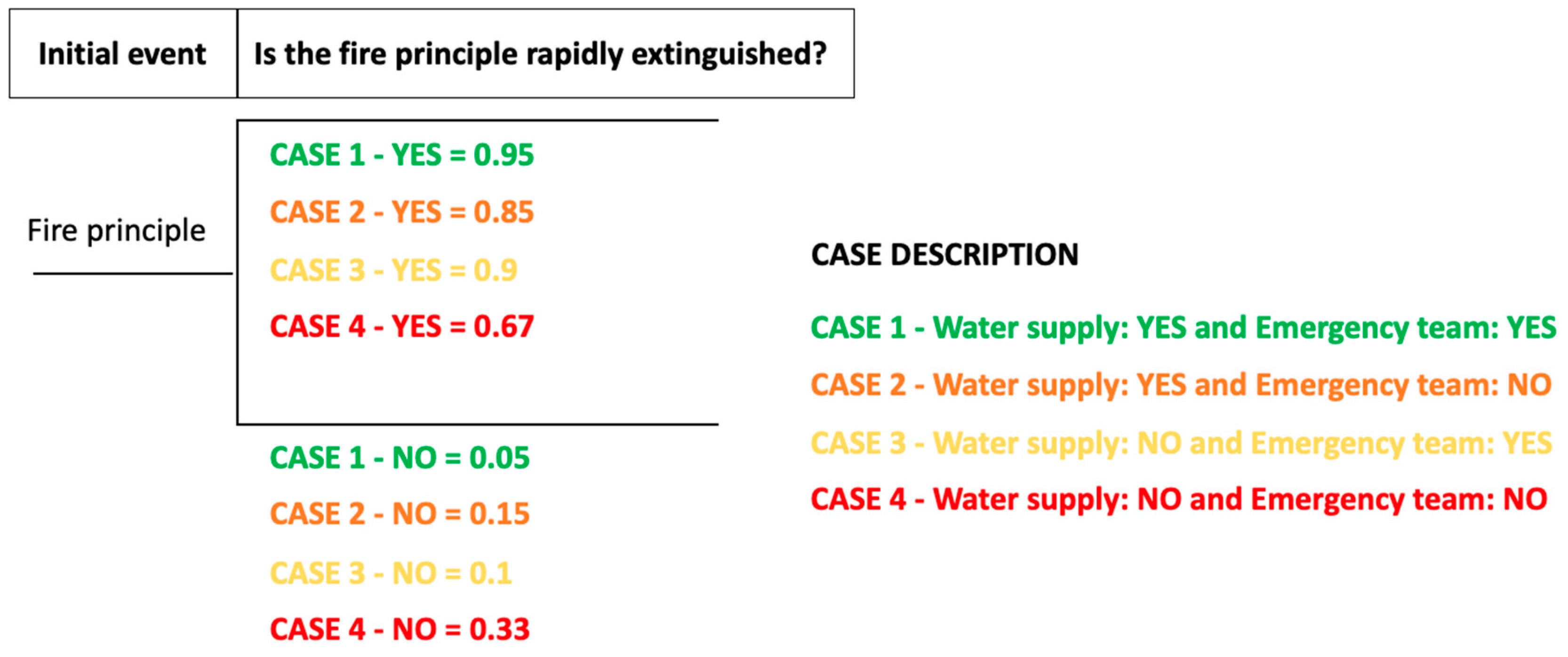


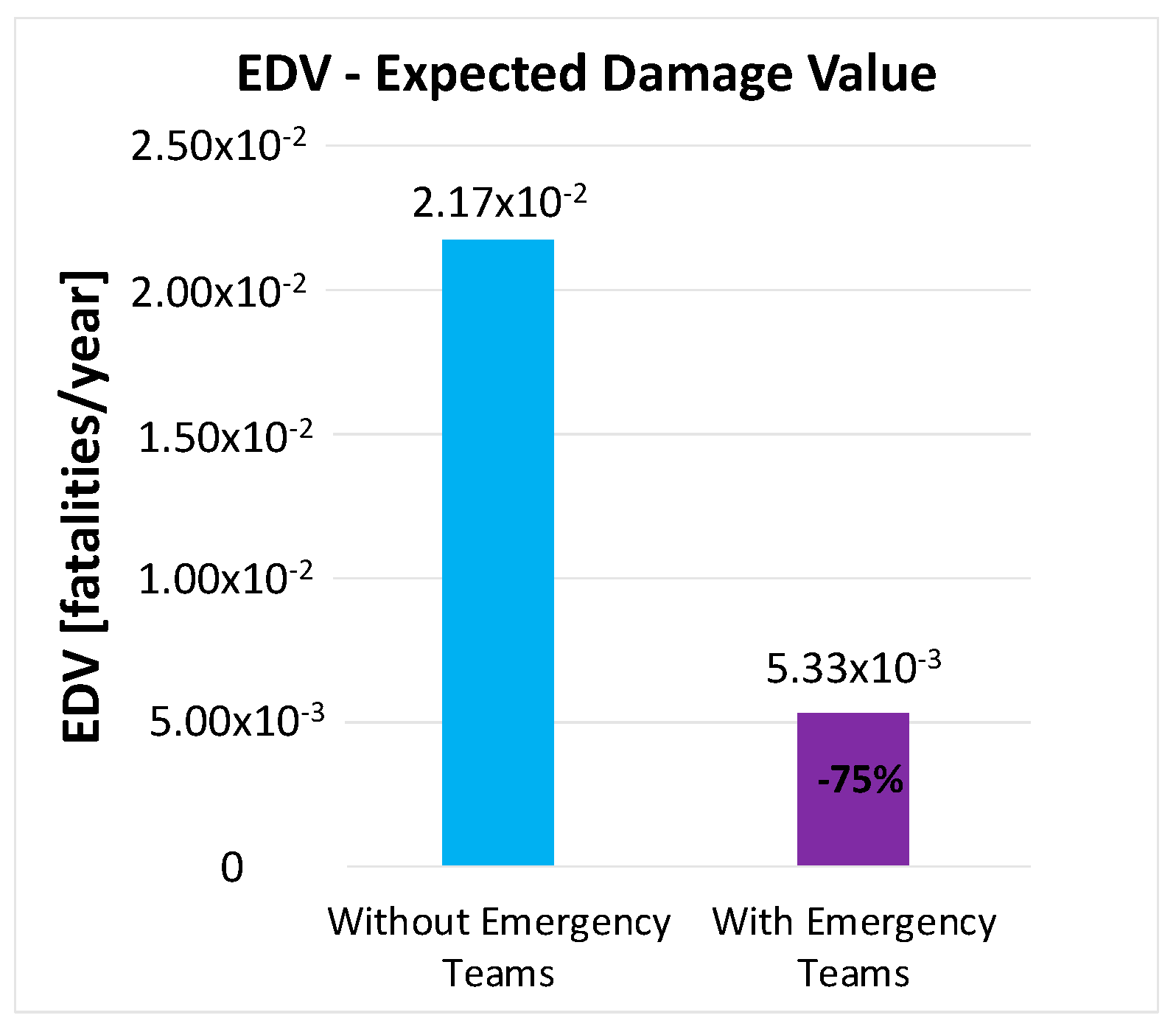
| Preparedness | Mitigation | Response | Recovery |
|---|---|---|---|
| Activities taken by an entity to define the hazardous environment to which it is subject | Activities taken prior to an event to reduce the frequency or the severity of a possible accidental event | Immediate and ongoing activities, procedures and systems that have been undertaken or developed to manage the adverse effects of an event | Activities and programs designed to effectively and efficiently restore conditions to a level that is acceptable to the entity |
| Tunnel Class | Description | Intervention Time of Emergency Teams |
|---|---|---|
| Class I | Tunnels where the transit of dangerous goods is forbidden | Emergency teams may be able to operate for any response time and fire size |
| Class II | One-way tunnels in which automatic extinguishing systems are installed or which can be reached within 8 min by emergency teams. All fires can be controlled by both emergency teams and automatic systems | t < 8 min |
| Class III | One-way tunnels. Teams are able to control slow developing fires | 8 min < t < 20 min |
| Class IV | Congested and/or two-way tunnels. High probability of fire and fire spread | t > 20 min |
| Type of Fire | Fire Curve |
|---|---|
| Self-developed (69.6%) | A; B |
| Following Collision (30.4%) | C; D |
| Fire Curve | Fire Characteristics | HRR (Heat Release Rate) |
|---|---|---|
| A | Slow developing fire with spread that is suppressed by emergency teams | The peak power (HRR—heat release rate) does not exceed the limit (see Figure 4). The power decreases as emergency teams intervene |
| B | Slow developing fire with late intervention of the teams | The peak power exceeds the limit before the teams have intervened |
| C | Rapidly developing fire with no possibility of spread | Peak power does not allow the fire to spread, possibly because of team intervention |
| D | Rapidly developing fire with possibility of spreading | Rapidly developing, high-powered fire that is spreading |
| Tube Name [R = Right Tube; L= Left Tube] | Length [m] | |
|---|---|---|
| 1 | Ara Salere R | 606 |
| 2 | Ara Salere L | 589 |
| 3 | Roviano R | 805 |
| 4 | Roviano L | 807 |
| 5 | Genzano R | 741 |
| 6 | Genzano L | 738 |
| 7 | Colle Castiglione R | 863 |
| 8 | Colle Castiglione L | 878 |
| 9 | Colledara R | 910 |
| 10 | Colledara L | 916 |
| 11 | Colle Mulino R | 1110 |
| 12 | Colle Mulino L | 1023 |
| 13 | San Giacomo R | 1029 |
| 14 | San Giacomo L | 1025 |
| 15 | Pietrasecca R | 1132 |
| 16 | Pietrasecca L | 1133 |
| 17 | Stonio R | 1243 |
| 18 | Stonio L | 1191 |
| 19 | Monte S. Angelo R | 1585 |
| 20 | Monte S. Angelo L | 1573 |
| 21 | Collurania R | 2088 |
| 22 | Collurania L | 2108 |
| 23 | San Rocco R | 4183 |
| 24 | San Rocco L | 4176 |
| 25 | San Domenico R | 4547 |
| 26 | San Domenico L | 4557 |
| 27 | Gran Sasso R | 10,121 |
| 28 | Gran Sasso L | 10,116 |
| Tunnel Tube [R = Right; L = Left] | Event Date [DD/MM/YYYY] | Vehicle Involved [LV: Light Vehicle] [HV: Heavy Vehicle] | A-Event Hour [hh:mm] | Event Type | B-Emergency Team Activation [hh:mm] | C-Arrival on Site [hh:mm] | Intervention Time [min] [C-A] | Fire Extinguishing Time [min] | Event Resolution Time [min] |
|---|---|---|---|---|---|---|---|---|---|
| San Domenico L | 01/05/2019 | 2 LV | 16:44 | Accident + injured | 16:44 | 16:50 | 6 | - | 118 |
| San Rocco L | 12/05/2019 | 2 LV | 12:05 | Accident + injured | 12:05 | 12:15 | 10 | - | 62 |
| San Domenico L | 11/06/2019 | LV | 15:37 | Failure + fire | 15:39 | 15:45 | 8 | - | |
| Gran Sasso L | 15/06/2019 | LV | 18:20 | Accident + injured | 18:22 | 18:30 | 10 | - | 47 |
| Stonio L | 22/06/2019 | LV | 20:43 | Failure + fire | 20:47 | 20:48 | 5 | 6 | |
| Gran Sasso L | 29/06/2019 | LV | 10:46 | Failure + fire | 10:47 | 10:53 | 7 | - | 99 |
| San Domenico L | 15/08/2019 | LV | 19:36 | Failure + fire | 19:40 | 19:43 | 7 | 21 | 70 |
| Gran Sasso L | 29/08/2019 | LV | 07:21 | Failure + fire | 07:22 | 07:26 | 5 | 10 | 69 |
| San Rocco L | 25/09/2019 | 2 LV | 08:49 | Accident + injured | 08:50 | 08:54 | 5 | - | 52 |
| Collurania L | 02/01/2020 | LV | 18:44 | Accident + injured | 18:45 | 18:48 | 4 | - | |
| San Rocco R | 21/02/2020 | LV | 09:40 | Failure + fire | 09:40 | 09:42 | 2 | - | 83 |
| San Rocco R | 23/02/2021 | LV | 12:23 | Failure + fire | 12:23 | 12:25 | 2 | 15 | 51 |
| Gran Sasso L | 29/06/2021 | HV | 10:02 | Failure + fire | 10.02 | 10:07 | 5 | - | 408 |
| Gran Sasso L | 15/10/2021 | LV | 08:27 | Failure + fire | 08:27 | 08:32 | 5 | 6 | 55 |
| Roviano R | 25/11/2021 | LV | 08:28 | Failure + fire | 08:32 | 08:35 | 7 | 24 | 49 |
| Parameter | Value |
|---|---|
| Length [m] | 1190 |
| Section [m2] | 54 |
| Number of lanes | 2 |
| Distance between the emergency exits [m] | 587; 38 |
| ADT—average daily traffic [vehicles/day] | 16,090 |
| Peak time flow when the analysis was carried out [vehicles/h] | 1609 (10% ADT) |
| Longitudinal slope [%] | −2.6 |
| Average number of passengers in a light vehicle | 2 |
| Average number of passengers in a heavy vehicle | 1.1 |
| Average number of passengers in a bus | 30 |
| Percentage of light vehicles [%] | 88 |
| Percentage of heavy vehicles [%] | 11 |
| Percentage of buses [%] | 1 |
| Average speed of the light vehicles [km/h] | 110 |
| Average speed of the heavy vehicles/buses [km/h] | 70 |
| Infrastructure Measures, Equipment and Management Procedures | Presence |
|---|---|
| Road signs | YES |
| Traffic lights and/or arrow-cross panels inside the tunnel | NO |
| Variable message panels inside the tunnel | YES |
| Emergency messages by radio for tunnel users | NO |
| Speakers in shelters and at emergency exits | NO |
| Emergency lighting | YES |
| Emergency pedestrian platforms | YES |
| Emergency team | YES |
| Emergency ventilation | YES |
| Control center | YES |
| TVCC with AID (automatic incident detection) | YES |
| Fibrolaser | YES |
| Traffic lights and/or arrow-cross panels at the tunnel entrance | YES |
| GSM (global system for mobile communications) coverage | YES |
| Emergency stations | YES |
| Fixed fire-fighting system | NO |
| Flammable liquid drainage | YES |
| Water supply | YES |
Publisher’s Note: MDPI stays neutral with regard to jurisdictional claims in published maps and institutional affiliations. |
© 2022 by the authors. Licensee MDPI, Basel, Switzerland. This article is an open access article distributed under the terms and conditions of the Creative Commons Attribution (CC BY) license (https://creativecommons.org/licenses/by/4.0/).
Share and Cite
Borghetti, F.; Frassoldati, A.; Derudi, M.; Lai, I.; Trinchini, C. Road Tunnels Operation: Effectiveness of Emergency Teams as a Risk Mitigation Measure. Sustainability 2022, 14, 15491. https://doi.org/10.3390/su142315491
Borghetti F, Frassoldati A, Derudi M, Lai I, Trinchini C. Road Tunnels Operation: Effectiveness of Emergency Teams as a Risk Mitigation Measure. Sustainability. 2022; 14(23):15491. https://doi.org/10.3390/su142315491
Chicago/Turabian StyleBorghetti, Fabio, Alessio Frassoldati, Marco Derudi, Igino Lai, and Cristian Trinchini. 2022. "Road Tunnels Operation: Effectiveness of Emergency Teams as a Risk Mitigation Measure" Sustainability 14, no. 23: 15491. https://doi.org/10.3390/su142315491






